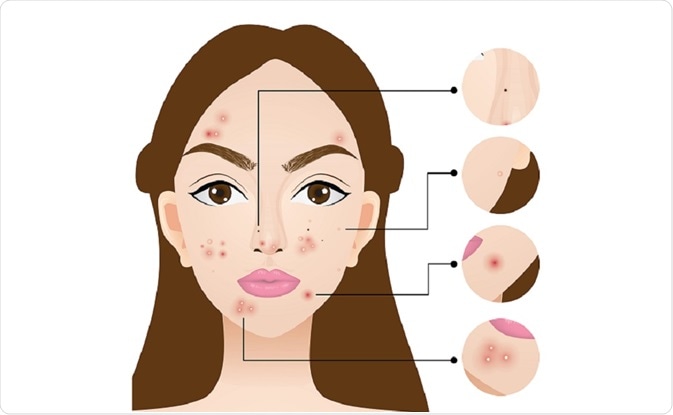
Acne Treatments
Acne is a common skin condition that causes oily skin, spots, and cysts. Almost everyone who experiences acne will develop the condition on their face, and a variety of treatments can be employed to reduce the severity of the condition.

charless | Shutterstock
What is acne?
Acne can develop with varying severity, and severe cases often involve cysts and nodules that may leave scarring when breakouts clear. There are six types of spot that acne can cause. These include:
- Blackheads: Bumps on the skin that are yellow or black in colour due to the pigmentation caused by the inner lining of hair follicles,
- Whiteheads: Similar bumps to blackheads but contain fluids,
- Papules: Small, painful red bumps,
- Pustules: Similar bumps to papules but are filled with white pus.
- Nodules: Big, hard bumps that form underneath the skin. Nodules can be painful to the touch.
- Cysts: Large, pus-filled spots that are likely to cause scarring.
Treating acne
For people with mild acne, over-the-counter medication can be an effective treatment. For those with more severe cases, prescribed antibiotics and topical treatments are often used. Some simple management tips include:
- Keeping skin clean by washing it gently twice a day
- Washing face if you have been doing activities that increase sweat production
- Avoid touching your skin
- Avoid using tanning beds
- Avoid picking or squeezing spots as this increases the risk of infection and scarring.
Which medications are recommended for acne?
Retinoids
Retinoids are derivatives of vitamin A that prevent the development of spots and are used to treat mild to moderate cases of acne. There are three main types of retinoids used for acne. They work by irritating the skin and increase the skin cell turnover. New cells replace the cells in existing spots and the increased turnover of cells can prevent new spots from developing.
Retinoids are considered a very effective treatment for acne, with a reduction of spots by 40 to 70%, and 4 out of 5 people reporting clear skin after 4 months of use. However, they come with a range of side-effects, including dry skin, sun sensitivity, nosebleeds, aches and pains, and more serious side effects can include anxiety or other mental health problems, vomiting, and is likely to harm unborn babies.
Antimicrobials
When used for acne, antimicrobials slow or stop the spread of bacteria and yeasts. Various types of antimicrobials have been found to reduce inflammatory lesions by up to 86%. However, it is thought that antimicrobials should be used less often or only for short periods of time to avoid bacterial resistances to medications developing.
There is a particularly strong medicine that tackles all of the causes of acne available, but due to the side effects patients choosing this course of medication must be regularly monitored by a healthcare professional. Side effects from this medication include rashes, diarrhea and yeast infections like thrush. However, around 85% of patients are able to permanently clear their acne after a single course of this medication.
Oral antibiotics
The first treatment usually used is a course of antibiotics with medicine that is applied to the skin to reduce the number of bacteria and clogged pores. Oral antibiotics are both antimicrobial and anti-inflammatory. However, some bacteria, in particular, Propionibacterium acnes (P. acnes) have become resistant to certain antibiotics. If one antibiotic does not work to clear the acne, other types of antibiotics can be tried.
Birth control
For women, birth control pills can be an effective treatment for acne. Birth control can be used in conjunction with antibiotics and other, acne-specific medicine.
Using contraceptives for acne treatment is available only for women. These hormonal treatments decrease androgen expression, as androgens play a key part in the development of acne. A study involving 128 women showed a reduction in spots by 63%.
While treatments for acne usually tackle more than one of the known causes of the condition, using multiple treatments in conjunction with one another often delivers the best results.
Natural treatments for acne
Natural treatments for acne are becoming more popular as they often pose fewer side effects and having better tolerance rates in patients. Tea tree oil, which is derived from the Melaleuca alternifolia plant in Australia is one example.
As it is widely available in shops, it is a popular treatment for acne. It acts as an antimicrobial and has been reported to have a similar efficacy to antimicrobials, although it does not produce results as quickly.
Vitex agnus-castus, which is a tree native to Asia and the Mediterranean, is used for acne that worsens before menstruation in women. It decreases estrogen levels. It is not recommended for use in pregnant or nursing women, and it does pose some risk of side effects.
Treatments not recommended for acne
Corticosteroids
Corticosteroids come in different forms, for instance in creams, lotions, gels, mousses, or ointments. They are also available in four different strengths. The stronger forms can only be acquired with a prescription. Although corticosteroids are used for other skin conditions like atopic eczema or psoriasis, it is not recommended for acne as it can worsen the symptoms.
Toothpaste
A common misconception is that toothpaste can help to dry up spots. However, toothpaste contains other ingredients that can irritate the skin, and as such is not a recommended treatment for acne.
Sources
- https://beta.nhs.uk/medicines/isotretinoin-capsules/#advice-for-women
- https://jamanetwork.com/journals/jama/fullarticle/199214
- https://uhs.berkeley.edu/sites/default/files/acne.pdf
- https://www.aad.org/public/diseases/acne-and-rosacea/severe-acne
- https://www.karger.com/Article/Abstract/67820
- https://www.ncbi.nlm.nih.gov/pmc/articles/PMC4740760/
Further Reading
Last Updated: Dec 17, 2018






















.png)










No hay comentarios:
Publicar un comentario